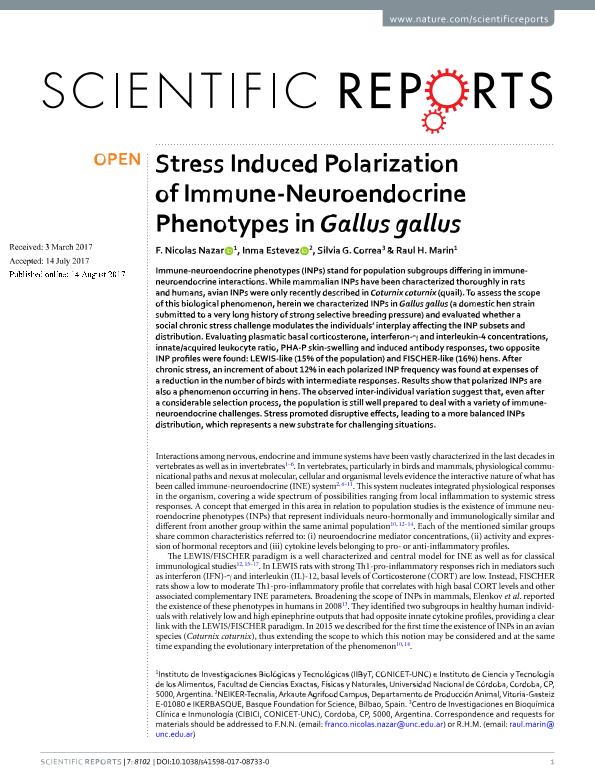Mostrar el registro sencillo del ítem
dc.contributor.author
Nazar, Franco Nicolas

dc.contributor.author
Estevez, Inma
dc.contributor.author
Correa, Silvia Graciela

dc.contributor.author
Marin, Raul Hector

dc.date.available
2018-04-20T17:28:52Z
dc.date.issued
2017-08-14
dc.identifier.citation
Nazar, Franco Nicolas; Estevez, Inma; Correa, Silvia Graciela; Marin, Raul Hector; Stress induced polarization of immune-neuroendocrine phenotypes in Gallus gallus; Springer Nature; Scientifics Reports; 7; 8102; 14-8-2017; 1-11
dc.identifier.issn
2045-2322
dc.identifier.uri
http://hdl.handle.net/11336/42851
dc.description.abstract
Immune-neuroendocrine phenotypes (INPs) stand for population subgroups differing in immune-neuroendocrine interactions. While mammalian INPs have been characterized thoroughly in rats and humans, avian INPs were only recently described in Coturnix coturnix (quail). To assess the scope of this biological phenomenon, herein we characterized INPs in Gallus gallus (a domestic hen strain submitted to a very long history of strong selective breeding pressure) and evaluated whether a social chronic stress challenge modulates the individuals’ interplay affecting the INP subsets and distribution. Evaluating plasmatic basal corticosterone, interferon-γ and interleukin-4 concentrations, innate/acquired leukocyte ratio, PHA-P skin-swelling and induced antibody responses, two opposite INP profiles were found: LEWIS-like (15% of the population) and FISCHER-like (16%) hens. After chronic stress, an increment of about 12% in each polarized INP frequency was found at expenses of a reduction in the number of birds with intermediate responses. Results show that polarized INPs are also a phenomenon occurring in hens. The observed inter-individual variation suggest that, even after a considerable selection process, the population is still well prepared to deal with a variety of immune-neuroendocrine challenges. Stress promoted disruptive effects, leading to a more balanced INPs distribution, which represents a new substrate for challenging situations.
dc.format
application/pdf
dc.language.iso
eng
dc.publisher
Springer Nature
dc.rights
info:eu-repo/semantics/openAccess
dc.rights.uri
https://creativecommons.org/licenses/by-nc-sa/2.5/ar/
dc.subject
Stress
dc.subject
Immune
dc.subject
Endocrine
dc.subject
Avian
dc.subject.classification
Otras Ciencias Biológicas

dc.subject.classification
Ciencias Biológicas

dc.subject.classification
CIENCIAS NATURALES Y EXACTAS

dc.title
Stress induced polarization of immune-neuroendocrine phenotypes in Gallus gallus
dc.type
info:eu-repo/semantics/article
dc.type
info:ar-repo/semantics/artículo
dc.type
info:eu-repo/semantics/publishedVersion
dc.date.updated
2018-04-16T14:06:15Z
dc.identifier.eissn
2045-2322
dc.journal.volume
7
dc.journal.number
8102
dc.journal.pagination
1-11
dc.journal.pais
Reino Unido

dc.journal.ciudad
Londres
dc.description.fil
Fil: Nazar, Franco Nicolas. Consejo Nacional de Investigaciones Científicas y Técnicas. Centro Científico Tecnológico Conicet - Córdoba. Instituto de Investigaciones Biológicas y Tecnológicas. Universidad Nacional de Córdoba. Facultad de Ciencias Exactas, Físicas y Naturales. Instituto de Investigaciones Biológicas y Tecnológicas; Argentina
dc.description.fil
Fil: Estevez, Inma. Centro de Investigación. Neiker - Tecnalia; España
dc.description.fil
Fil: Correa, Silvia Graciela. Consejo Nacional de Investigaciones Científicas y Técnicas. Centro Científico Tecnológico Córdoba. Centro de Investigaciones en Bioquímica Clínica e Inmunología; Argentina
dc.description.fil
Fil: Marin, Raul Hector. Consejo Nacional de Investigaciones Científicas y Técnicas. Centro Científico Tecnológico Conicet - Córdoba. Instituto de Investigaciones Biológicas y Tecnológicas. Universidad Nacional de Córdoba. Facultad de Ciencias Exactas, Físicas y Naturales. Instituto de Investigaciones Biológicas y Tecnológicas; Argentina
dc.journal.title
Scientifics Reports
dc.relation.alternativeid
info:eu-repo/semantics/altIdentifier/url/https://www.nature.com/articles/s41598-017-08733-0
dc.relation.alternativeid
info:eu-repo/semantics/altIdentifier/doi/http://dx.doi.org/10.1038/s41598-017-08733-0
Archivos asociados
